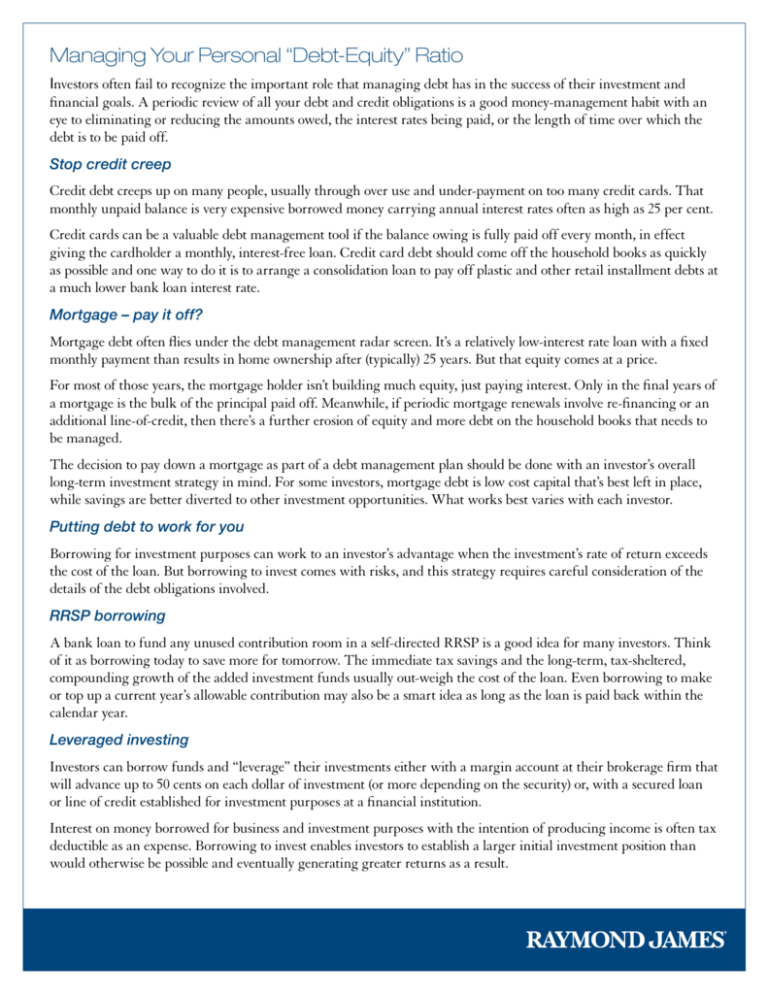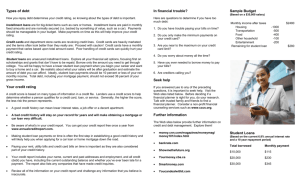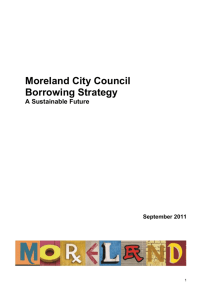Managing Your Personal “Debt-Equity” Ratio
advertisement

Managing Your Personal “Debt-Equity” Ratio Investors often fail to recognize the important role that managing debt has in the success of their investment and financial goals. A periodic review of all your debt and credit obligations is a good money-management habit with an eye to eliminating or reducing the amounts owed, the interest rates being paid, or the length of time over which the debt is to be paid off. Stop credit creep Credit debt creeps up on many people, usually through over use and under-payment on too many credit cards. That monthly unpaid balance is very expensive borrowed money carrying annual interest rates often as high as 25 per cent. Credit cards can be a valuable debt management tool if the balance owing is fully paid off every month, in effect giving the cardholder a monthly, interest-free loan. Credit card debt should come off the household books as quickly as possible and one way to do it is to arrange a consolidation loan to pay off plastic and other retail installment debts at a much lower bank loan interest rate. Mortgage – pay it off? Mortgage debt often flies under the debt management radar screen. It’s a relatively low-interest rate loan with a fixed monthly payment than results in home ownership after (typically) 25 years. But that equity comes at a price. For most of those years, the mortgage holder isn’t building much equity, just paying interest. Only in the final years of a mortgage is the bulk of the principal paid off. Meanwhile, if periodic mortgage renewals involve re-financing or an additional line-of-credit, then there’s a further erosion of equity and more debt on the household books that needs to be managed. The decision to pay down a mortgage as part of a debt management plan should be done with an investor’s overall long-term investment strategy in mind. For some investors, mortgage debt is low cost capital that’s best left in place, while savings are better diverted to other investment opportunities. What works best varies with each investor. Putting debt to work for you Borrowing for investment purposes can work to an investor’s advantage when the investment’s rate of return exceeds the cost of the loan. But borrowing to invest comes with risks, and this strategy requires careful consideration of the details of the debt obligations involved. RRSP borrowing A bank loan to fund any unused contribution room in a self-directed RRSP is a good idea for many investors. Think of it as borrowing today to save more for tomorrow. The immediate tax savings and the long-term, tax-sheltered, compounding growth of the added investment funds usually out-weigh the cost of the loan. Even borrowing to make or top up a current year’s allowable contribution may also be a smart idea as long as the loan is paid back within the calendar year. Leveraged investing Investors can borrow funds and “leverage” their investments either with a margin account at their brokerage firm that will advance up to 50 cents on each dollar of investment (or more depending on the security) or, with a secured loan or line of credit established for investment purposes at a financial institution. Interest on money borrowed for business and investment purposes with the intention of producing income is often tax deductible as an expense. Borrowing to invest enables investors to establish a larger initial investment position than would otherwise be possible and eventually generating greater returns as a result. But, there are definite risks. Borrowing for investment purposes can be a “double-edged sword.” If the expected investment returns don’t materialize, leveraged borrowing can actually make a bad situation worse, creating losses that trigger a margin call (for more money) if a stock or basket of stocks decline in value or, if the bank loan agreement requires more collateral to be put up, forcing the investor to sell or pledge other assets in order to raise the required capital. As a debt management strategy investment borrowing should involve consultation with a tax professional and a financial advisor who can explain the details, obligations and responsibilities of leveraged investing. Your Raymond James Financial Advisor is familiar with the debt management strategies that can work for you and that might contribute to your long-term investment goals and objectives. Securities-related products and services are offered through Raymond James Ltd., Member Canadian Investor Protection Fund. Iinsurance products and services are offered through Raymond James Financial Planning Ltd., which is not a Member-Canadian Investor Protection Fund.







